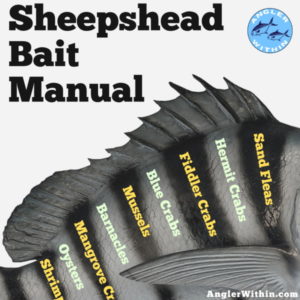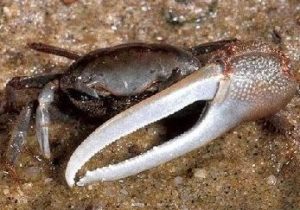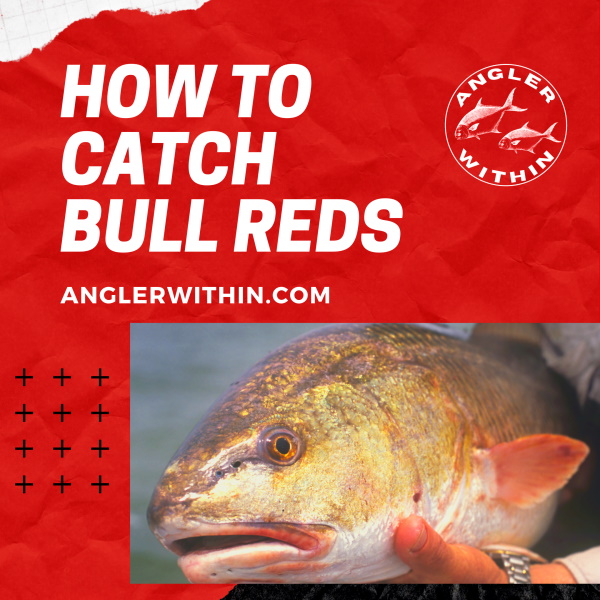
To catch bull redfish from shore, you should concentrate your efforts when they’re actually near the beaches, bays, rivers, inlets and jetties. Prime times vary by region, but generally speaking fall is the best time for old drum. Fall is when mature drum make their move from offshore to nearshore waters for the spawn. Soak large baits on the bottom, preferably blue crab, bunker, or mullet, and hold on tight.
Let’s get into the details below.
- What Is A Bull Redfish
- When To Catch Them
- Where To Find Them
- Best Baits
- Best Rigs
- Gear To Use
- Landing Bull Reds
What Is A “Bull” Redfish?
(Sciaenops ocellatus)
The term “Bull Red” is somewhat arbitrary. It refers to mature red drum, of either sex, that have attained a certain large size.
The particular size that a red has to get to, before someone calls it a bull, is really just a matter of opinion, and will vary by region. Most anglers use the term for any redfish over the slot limit set by their state. Others don’t consider a redfish to really be a bull until it’s over 3 feet long.
North Carolina anglers would likely chuckle about what some other places call bulls. This is for good reason, as they commonly catch true giants in the Tar Heel State.
The current record is over 94lbs caught in Hatteras, North Carolina in 1984.
For the sake of discussion, we’re referring to redfish that have reached sexual maturity, and are above the slot limit set forth by each state (see chart below). These fish are at least 3 years old, and exhibit much different behavior than their younger counterparts. Therefore, I think it’s fair to declare these fish as “bulls”, as they are in fact the breeders.
Why Is There A Slot Limit On Redfish?
The purpose of the upper slot size is to protect these larger breeder sized fish from over harvest.
Male and female redfish mature at different ages, but more or less they begin to spawn at around 26″ in length. That is why the upper slot is typically somewhere around that 26″ mark.
Once redfish grow to approximately 26″ (upper slot), they will transition from inshore living to offshore living. These old drum are the brutes that we want to pursue.
Large bull redfish are often between 20 and 30 years old, and are known to even live up to 56 years old, and possibly older.
Average Redfish Growth Rates
As shown in the chart below, the weight of mature redfish typically works out to be approximately 1 pound per inch. So, a 50″ redfish is going to be somewhere around 50 pounds. With this knowledge, there isn’t much of a need to weigh these giants. Telling someone you caught a 50″ bull should suffice for bragging rights.
| AGE | INCHES |
|---|---|
| 1 | 12 |
| 2 | 19 |
| 3 | 24 |
| 4 | 27 |
| 5 | 30 |
| 6 | 32 |
| 7 | 34 |
| 8 | 35 |
| 9 | 36 |
| 10 | 37 |
Females Are Bigger Than Males
Seems kind of strange that you would call females “bulls” doesn’t it? But that’s indeed the case more often than not. Although males mature more quickly, and can attain a large size, they don’t top out as big as females do.
State Redfish Records
Below are the current state records for all states where redfish are commonly pursued. As you can see, most of the largest redfish typically come from the Atlantic coast, from South Carolina to Virginia.
| STATE | RECORD | SLOT | |
|---|---|---|---|
 | Texas | 39.13 lbs. | 20-28" |
 | Louisiana | 61 lbs. | 16-27" |
 | Mississippi | 52 lbs. 4.2 oz. | 18-30" |
 | Alabama | 45 lbs. 9 oz. | 16-26" |
 | Florida | 60.75 lbs. | 18-27" |
 | Georgia | 47 lbs. 7 oz. | 14-23" |
 | South Carolina | 75 lbs. | 15-23" |
 | North Carolina | 94 lbs. 2 oz. | 18-27" |
 | Virginia | 85 lbs. 4 oz. | 18-26" |
 | Delaware | 75 lbs. | 20-27" |
 | New Jersey | 55 lbs. | 18-27" |
When To Catch Bull Reds
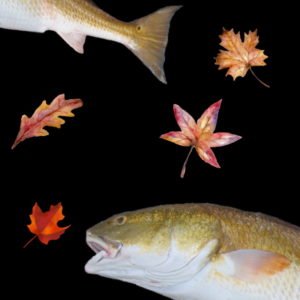
The best time to pursue old drum is during the annual bull red run, the timing of which will depend on your area.
What Is The Bull Redfish Run?
(The Spawn)
The “run” simply refers to the movement of mature redfish, as it relates to their annual spawn.
In most of the country, mature reds spend the majority of their lives offshore. However, during the spawn they temporarily relocate to nearshore waters, particularly around rivers, passes, bays and inlets. This annual bull red run is when many old drum are within reach of shore fishermen.
While it’s true that the annual incoming run of offshore red drum provides us access to the largest redfish out there, that doesn’t tell the whole story. There is yet another separate wave of younger “bulls” that provide us with even more opportunity at big fish.
At around age 3 or 4, most redfish quickly transition from an inshore and nearshore species to becoming an offshore species. This younger wave of newly-matured reds migrate out of inshore waters for the first time in the fall. They meet up with schools of older drum that have made their way in from offshore.
Unlike most of the country, there is a notable exception, in Florida, where bulls don’t actually migrate out to the open ocean after the spawn. That special location is the Indian River and Mosquito Lagoon. The bull reds here live out their entire lives within these waters.
When their first spawn is over, newly matured “bulls” will move offshore with the rest of the schools to begin their offshore stage of life. This offshore move happens when the water temps begin to drop in the wintertime.
It should be noted that some fish beyond age 3 to 4 will choose to remain part of the local population for a while longer. That’s why catching a fairly large redfish is always a possibility in some regions, no matter the time of year.
In most areas, redfish lay their eggs along the beaches. Tidal currents carry those eggs through the passes and inlets into bays and other backwaters. Here the young are better able to survive.
Peak Times For Targeting Bull Redfish
Below are what I view to be the peak “run” times for most years on average. This can vary year, and fishing can still be good on either side of the ranges. So, use this only as a loose guide on what time of year is best in your region.
The preferred water temps are the low to mid 60’s. That will be the driving factor of when bulls make their move to nearshore, and then back offshore.
Best Times By State
- Texas
- September – October
- Some areas are even good through winter
- Louisiana
- Late August – September, but pretty much all year is good
- Mississippi
- September – November
- Alabama
- October – November
- Florida
- Northeast Florida – August – October
- Daytona Beach – October – December
- Florida Panhandle – October – December
- Georgia
- September – November
- South Carolina
- October – November
- North Carolina
- Outer Banks – October – November, March – April
- Pamlico Sound – August – September
- Virginia
- May – September
Where To Catch Bull Reds From Land
Redfish range from Texas, around Florida, and up the Atlantic coast to New Jersey, and beyond. So, they are a very widespread and popular species as you can see.
Once you have an idea of when to focus your efforts, you’ll then have to determine where to find spawning redfish. Although options are limited, if you don’t have a boat, that doesn’t stop you from hitting some of the very best areas.
3 things come together during the annual bull red run that give shore fishermen, in particular, a great chance to hook up with one. Redfish are nearshore, they are on the move, and they are hungry. If you soak a good bait in a prime area during a prime time, you’re sure to catch them.
So, what are the prime areas we should target during the run? Well, bull reds typically use ledges, contours, or shorelines as underwater highways as they make their moves during the spawn. Fortunately, those are all features that we can target as shore fishermen. Below are the best places where you can intercept spawning bulls from land.
Best Locations For Land Based Anglers
- Beaches
- Passes
- Bays
- Jetties
- Piers
- River Mouths
As land based anglers, we have access to some of the most productive places where the 2 groups of large reds mingle in the fall. Beaches, passes, bays, jetties, river banks, and piers are all extremely effective areas where we can intercept hefty redfish.
Most consistent successes will be had either in the passes, or on beaches closest to the passes. That’s certainly not to say you can’t hook into them elsewhere.
Anywhere you can find deeper water will typically be better. So, when fishing from the beaches, it’s best if you cast your bait into the 2nd trough from the beach, if not further.
Fishing at night seems to increase your chances of catching bulls. However, your chances of hooking sharks increases as well. So, it’s a tradeoff. You’ll have to deal with more sharks if you fish at night.
Baits for Old Drum
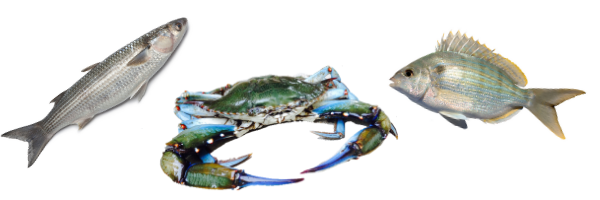
Although they can occasionally be found feeding anywhere in the water column, fishing for bull reds is primarily a bottom fishing game. Because redfish rely heavily on their sense of smell when feeding, you don’t have to necessarily put the bait right in their face.
Large redfish will follow a scent trail to it’s source. Therefore, throwing out a large desirable bait, and either letting it sit still, or slowly drift along the bottom, is the most common tactic.
Bull reds are not really too picky when it comes to bait, but the best 3 are blue crab, mullet and bunker. Other solid options are ladyfish, pinfish, spots, croaker, whiting and sand trout.
Blue crabs can be fished whole, or they can be cut in half. The other fishy options are most often cut up into chunks 2 – 4″ long. However, the right sized fish can be used as live bait as well, if it’s not too big. It’s worth pointing out that, for whatever reason, mullet heads are an amazing bull red bait.
No matter what bait you choose, it needs to be fresh. It’s best if you keep it alive until right before putting it on the hook. If that isn’t possible, keep it on ice until you are ready to use it. While frozen baits can work, you should always strive to avoid them if you have other options.
For more info on baits, check out my article on The Best Baits For Bull Reds.
Rigs For Bull Reds

For land based drum fishing, an ideal bull red rig will generally consist of a strong snelled 4/0 – 12/0 circle hook, a heavy mono leader, and a stationary style of sinker (pyramid, tongue, Sputnik). This could be a fish finder rig, a cannonball rig, a knocker rig, an old drum rig, or any number of variations on those designs.
Main Line
Your main line should be 30-50 lb. braid or 20-30 lb. monofilament. If you go with a lighter weight monofilament, such as 20 lb. mono, you’ll potentially need to use a shock leader between your main line and your rig. That’s because a heavy sinker combined with a piece of heavy bait can break light line during the cast.
Hooks
The main things with hook selection is that it needs to be strong, and the hook size should somewhat match your bait size. Your hook should not be over-choked by the bait. Make sure you have plenty of hook point exposed.
Sinkers
Sinker size is dictated by the amount of current you have to deal with, and how far you need to cast. Use the lightest weight you can get away with and still hold bottom. Some anglers use as much as 10 oz. or more when drum fishing.
Leader Material
The further you need to cast, the shorter you should probably make your leader. The leader, pictured above, could be shortened to as little as 1″ and still remain effective for drum fishing.
For more detailed information on good bull red rigs, check out my write up on that here – The Best Rigs For Bull Reds.
Best Reels For Bull Redfish
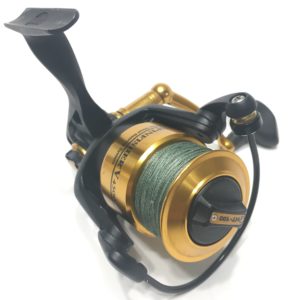
Larger bull reds are the vital breeder fish, so you shouldn’t drag the fight out beyond a reasonable time. Doing so really tires the fish out, and can drastically increase mortality rate. Therefore, it’s best to leave the really lightweight gear at home.
The minimum sized reel you should probably use is a 4500 class reel, like the Spinfisher V pictured above. I prefer reels 6000 and up for land based old drum fishing.
Spool your reel up with at least 250 yards of 30-50 lb. braid or 20-30 lb mono. With this kind of setup, you can put some pressure on the fish, to get it in quickly.
If you’re fishing an area near structure, such as rocks or bridge pilings, you’ll definitely want to lean towards a heavier setup.
Best Rods For Bull Redfish
Rod Strength
When fishing from shore, you’ll want a rod with some backbone, for 2 reasons. Firstly, you’ll want to be able to put adequate pressure on a fish to reduce the fight time, which is much better for them. Additionally, because you’ll sometimes be casting very heavy weights (8 oz.) and large baits, you’ll need a strong rod capable of handling such a payload. I prefer Medium-Heavy, Heavy, or Extra-Heavy rods for shore fishing.
Depending on where you’re fishing, you may have to get a bait out very far and keep it down in heavy current. To do so requires a heavy sinker, which cannot be effectively casted using short lightweight rods.
Hatteras, North Carolina comes to mind. The proper tool for the job, in locations such as the “The Point” at Hatteras, is an 8nbait setup, which I discuss in detail here – What Are 8nBait Rods.

Rod Length
Depending on where you’ll be fishing will have some impact on how long a rod to use. A 7 foot medium-heavy rod works fine if you don’t have to cast far. However, when fishing from the beach, you’ll usually want to launch a heavy payload a great distance. In those cases, I like a 9-12 foot rod.
For some additional guidance on how to choose a surf rod, you can check out my article about that here – 9 Criteria To Consider When Choosing A Surf Rod.
Landing Bull Reds
When fishing for bull reds, make sure you haven’t locked your drag all the way down. There will be a powerful initial run, and you don’t want the line to break. Allow them to have that initial surge before reeling. You shouldn’t try to reel against a screaming drag.
You can expect several strong surges from a bull red before being able to fully reel them in.
When landing a fish on the beach, use the incoming waves to help surf your bull onto the sand. If you try to horse it through the shallows, you’ll run the risk of popping your line.
Holding A Bull Red
When handling really large redfish, you should never hold it vertically. Instead, cradle it horizontally to prevent damage to the jaw, and to reduce the internal stresses of the organs. Take your photos quickly, and return the fish to the water promptly.
Reviving A Tired Redfish
If you do tire a fish completely out, it’s critical that you revive it before the release. Hold the tail and push it back and forth in the water so the gills receive fresh oxygen. It will take longer to revive a fish in warmer water than in cooler water. Once the fish kicks his tail a time or 2 in your hand, he is ready to go back.
Regulations
Red drum are very plentiful, thanks mostly in part to the stringent regulations placed on them. All states of the Gulf and along the Atlantic have a slot limit in effect. Most states either don’t allow you to keep an over slot fish, or they only let you keep 1.
Regardless of the regulations, most anglers release mature reds, as they are the breeders that ensure a healthy population. The only exception for me personally would be a deeply hooked fish that I felt like wouldn’t survive anyway.
Are Bull Reds Good To Eat?
In short, bull reds are not a great fish to keep for the dinner table. Old drum have a more course and less tasty flesh than their younger counterparts, not to mention they are a pain to clean. Most anglers that have kept a bull red, regret ever taking them home.
Conclusion
If you’re confined to land, there isn’t a much more accessible, larger, or harder fighting fish than a bull red. With the knowledge above, you can successfully target these beautiful brutes from shore.
Cheers,
Augustus Clay


